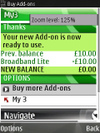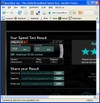
I arrived in the U.K. yesterday for attending the Oxford University Future Technology Conference in Oxford today. Naturally, wireless Internet connectivity needed to be assured right away, so I figured I would go and buy a ‘3’ Pay As You Go SIM and activate the 1 GB for 30 days broadband Internet access offer (for details, see here). I managed to get one in the end, as this blog entry is proof of, but it was a bit easier said than done:
The first ‘3’ store I found did not have prepaid SIMs without phones available, out of stock… O.k. no worries, there is more than one ‘3’ store in London. So I went to a second store which did have SIM cards but there I was told that the Internet would only work with their own phones. I challenged the guy, he gave me his SIM card and I showed how well it works in my non-‘3’ N95-8GB 🙂 Not that he knew what an ‘APN’ was…
After the initial denial phase, everything worked like a charm and I was set up in 5 minutes:
- Within a minute, I had a SIM card and a 10 pounds top up voucher and activated the SIM by calling 444.
- Before activating the Internet add-on, I had to make another call to 444 to put the 10 pounds on the SIM.
- Afterwards I went to the My3 web page received via the SMS above and activated the Internet Light 1GB add-on.
- Very nice, works like a charm 🙂

Speeds in London’s busy Oxford street are quite o.k., about 1 MBit/s in downlink and 60 kbit/s in uplink. Not the best I’ve ever seen but it will do nicely. Thanks, 3!

